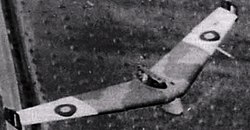Baynes Bat
| Baynes Bat | |
|---|---|

|
|
| Type: | Flying wing cargo glider |
| Design country: | |
| Manufacturer: | |
| First flight: |
July 1943 |
| Number of pieces: |
1 |
The Baynes Bat was a test aircraft that served as a feasibility study for a planned so-called Carrier Wing .
history
In 1941, the British sailplane designer LE Baynes suggested equipping a combat vehicle (for example, an 8 ½ ton tank) with removable wings so that it could be towed into the combat zone with the help of an airplane. The tank completely replaced the fuselage of the flying wing designed glider, there was also no landing gear. The engine of the tank should be started in the air after the release and the wings should be thrown off via a quick release when touching down.
The basic idea was considered good by an RAF staff, but the feasibility should first be tested on a manned 1: 3 model. This model was designed by Baynes and built by Slingsby Sailplanes in Kirkbymoorside, Yorkshire in 1943 and was given military registration RA809.
The first flight took place in July 1943 in Sherburn-in-Elmet at the Airborne Forces Experimental Establishment . Most of the test flights were carried out by First Lt. Robert Kronfeld performed. The flights demonstrated the good-natured flight characteristics of the design, but the project was not pursued any further, as cargo gliders were now available that could transport the corresponding tanks in the hold. Since the Bat was the first modern flying wing aircraft in the RAF that was available for research purposes, additional flights were carried out to obtain data on flight stability and control.
construction
The Bat was made entirely of wood and similar in its aerodynamic properties to the full-scale Carrier Wing . However, the model had a small gondola for the pilot. The swept wings had a main spar. There were no air brakes , but the Slingsby-patented spring-operated flaps were attached to the outer wings over half the span. At the ends of the wing there were end plates used as rudders. Only a skid was used as the main landing gear, a pair of small wheels were provided for moving on the ground.
Technical specifications
| Parameter | Data |
|---|---|
| crew | 1 |
| length | 3.46 m (11 ft 4 in) |
| span | 10.16 m (33 ft 4 in) |
| Wing area | 14.86 m² (160 ft²) |
| Wing extension | 7.0 |
| Empty weight | 346 kg (763 lb) |
| Takeoff weight | 437 kg (963 lb) |
| Cruising speed | 128 km / h (80 mph) |
| Top speed | 192 km / h (120 mph) |
| Stall speed | 64 km / h (40 mph) |
See also
literature
- Philip Jarrett: Nothing Ventured - Baynes Bat , Airplane Monthly, May 1990, pp. 266f.
